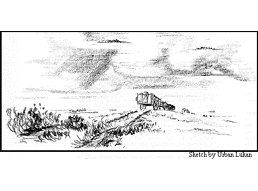![]()
|
|
|
|
|
|||||

Success Stories
The Sprit and the Soil: Early Settlement of Humboldt, Saskatchewan and Surrounding Communities
Collaborative Effort Puts Humboldt, Saskatchewan On the Internet
 The
Spirit and The Soil is a sprawling, colourful web site that depicts
the history of Humboldt, Saskatchewan and its surrounding area from the
1880s to 1990s. This project was researched, designed and developed for
the Information Highway this past summer by eight young people working
for the Carlton Trail Regional Economic Development Authority (REDA) in
Humboldt.
The
Spirit and The Soil is a sprawling, colourful web site that depicts
the history of Humboldt, Saskatchewan and its surrounding area from the
1880s to 1990s. This project was researched, designed and developed for
the Information Highway this past summer by eight young people working
for the Carlton Trail Regional Economic Development Authority (REDA) in
Humboldt.
The project was carried out under contract to Industry Canadaís SchoolNet Digital Collections program, which gives people 15 to 30 years of age entrepreneurial and technology-based job experience converting collections of Canadian material into digital form for display on SchoolNet. The SchoolNet Digital Collections web site has grown to become possibly the largest single source of Canadian content on the Information Highway.
Don Flannigan, Economic Development Coordinator of REDA, explained that the 600-page web site offers visitors a virtual tour of Humboldt that covers archival material from St. Peterís Abbey, a monastery founded by Benedictine monks and an important area landmark, to historic photographs of farms and buildings, to the Renaissance-inspired religious iconography of St. Peterís Cathedral by Berthold von Imhoff.
Flannigan said the Digital Collections project was a collaborative effort from start to finish. St. Peterís Abbey, the Humboldt and District Museum and Gallery, the Town of Humboldt Tourism and Special Events department, and the Humboldt Journal, to name a few, were among the institutions that contributed time and expertise to the site. But Flannigan explains that it was the team of eight young people who pulled all the elements together, and put the entire collection on the Internet.
The design team was headed by project leader Jason Perras, and included Nadine Frank, Caron MacDonald, Chad Eggerman, Colin Hawkins, Allison Fraser, Tina Stuckel and Corrine Kelly. Flannigan said none of the team members had any Internet publishing experience when they started out. "The SchoolNet Digital Collections project gave these young people the confidence to could learn about technology, and apply that knowledge to their own lives," he said. "They are proud to have contributed information on their home town to the Internet." Flannigan said the team enjoyed all aspects of the project, even the challenges. "They would all like to come back this summer for another similar experience," he said. "They enjoyed working as a group, and even found they were up to challenges like proof-reading, editing, and managing unfamiliar administrative details." Flannigan noted that young people are very aware of the important role Internet technology is playing in our lives today, and they are eager to be a part of that. "Digital Collections gives young people like these an opportunity to learn how this technology works," he said. "Once they have those skills and a little confidence, they feel better prepared for todayís working world."
|
Updated: |